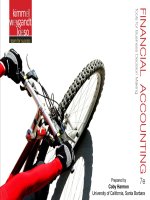Financial accounting 8e tool for busniess decision making chapter 11
Bạn đang xem bản rút gọn của tài liệu. Xem và tải ngay bản đầy đủ của tài liệu tại đây (3.17 MB, 92 trang )
11-1
11
Reporting and Analyzing
Stockholders’ Equity
Kimmel ● Weygandt ● Kieso
Financial Accounting, Eighth Edition
11-2
CHAPTER OUTLINE
LEARNING OBJECTIVES
11-3
1
Discuss the major characteristics of a corporation.
2
Explain how to account for the issuance of common
and preferred stock, and the purchase of treasury
stock.
3
Explain how to account for cash dividends and
describe the effect of stock dividends and stock splits.
4
Discuss how stockholders’ equity is reported and
analyzed.
LEARNING
OBJECTIVE
1
Discuss the major characteristics of a
corporation.
An entity separate and distinct from its owners.
Classified by Purpose
Classified by Ownership
Not-for-Profit
Publicly
For
Privately
Profit
►Salvation Army
►American
►IBM
Cancer
Society
held
►Cargill
Inc.
►Caterpillar
►General
11-4
held
Electric
LO 1
CHARACTERISTICS OF A CORPORATION
Characteristics that distinguish corporations from
proprietorships and partnerships.
Separate
Limited
Legal Existence
Liability of Stockholders
Transferable
Ability
to Acquire Capital
Continuous
Life
Corporation
Management
Government
Additional
11-5
Ownership Rights
Regulations
Advantages
Disadvantages
Taxes
LO 1
CHARACTERISTICS OF A CORPORATION
Characteristics that distinguish corporations from
proprietorships and partnerships.
Corporation acts
Separate Legal Existence
under its own name
rather than in the
Limited Liability of Stockholders
name of its
Transferable Ownership Rights
stockholders.
Ability to Acquire Capital
11-6
Continuous Life
Corporation Management
Government Regulations
Additional Taxes
LO 1
CHARACTERISTICS OF A CORPORATION
Characteristics that distinguish corporations from
proprietorships and partnerships.
11-7
Separate Legal Existence
Limited Liability of Stockholders
Transferable Ownership Rights
Ability to Acquire Capital
Continuous Life
Corporation Management
Government Regulations
Additional Taxes
Limited to their
investment.
LO 1
CHARACTERISTICS OF A CORPORATION
Characteristics that distinguish corporations from
proprietorships and partnerships.
Separate
Limited
Legal Existence
Liability of Stockholders
Transferable
Ability
Shareholders may
sell their stock.
to Acquire Capital
Continuous
Life
Corporation
Management
Government
Additional
11-8
Ownership Rights
Regulations
Taxes
LO 1
CHARACTERISTICS OF A CORPORATION
Characteristics that distinguish corporations from
proprietorships and partnerships.
Separate
Limited
Legal Existence
Liability of Stockholders
Transferable
Ability
to Acquire Capital
Continuous
Life
Corporation
Management
Government
Additional
11-9
Ownership Rights
Corporation can
obtain capital
through the issuance
of stock.
Regulations
Taxes
LO 1
CHARACTERISTICS OF A CORPORATION
Characteristics that distinguish corporations from
proprietorships and partnerships.
Separate
Limited
Legal Existence
Liability of Stockholders
Transferable
Ability
to Acquire Capital
Continuous
Corporation
Additional
Life
Management
Government
11-10
Ownership Rights
Regulations
Taxes
Continuance as a
going concern is not
affected by the
withdrawal, death, or
incapacity of a
stockholder, employee,
or officer.
LO 1
CHARACTERISTICS OF A CORPORATION
Characteristics that distinguish corporations from
proprietorships and partnerships.
Separate
Limited
Legal Existence
Liability of Stockholders
Transferable
Ability
to Acquire Capital
Continuous
Life
Corporation
Management
Government
Regulations
Additional
11-11
Ownership Rights
Taxes
Separation of
ownership and
management
prevents owners from
having an active role
in managing the
company.
LO 1
CHARACTERISTICS OF A CORPORATION
Characteristics that distinguish corporations from
proprietorships and partnerships.
Separate
Limited
Legal Existence
Liability of Stockholders
Transferable
Ability
Ownership Rights
to Acquire Capital
Continuous
Life
Corporation
Management
Government
Additional
11-12
Regulations
Taxes
LO 1
CHARACTERISTICS OF A CORPORATION
Characteristics that distinguish corporations from
proprietorships and partnerships.
Separate
Limited
Legal Existence
Liability of Stockholders
Transferable
Ability
to Acquire Capital
Continuous
Life
Corporation
Management
Government
Additional
11-13
Ownership Rights
Regulations
Taxes
Corporations pay
income taxes as a
separate legal entity
and in addition,
stockholders pay
taxes on cash
dividends.
LO 1
CHARACTERISTICS OF A CORPORATION
ILLUSTRATION 11-1
Corporation organization chart
Stockholders
Chairman and
Board of
Directors
President and
Chief Executive
Officer
General
Counsel/
Secretary
Vice President
Marketing
Treasurer
11-14
Vice President
Finance/Chief
Financial Officer
Vice President
Operations
Vice President
Human
Resources
Controller
LO 1
PEOPLE, PLANET, AND PROFIT INSIGHT
The Impact of Corporate Social Responsibility
A survey conducted by Institutional Shareholder Services, a proxy advisory
firm, shows that 83% of investors now believe environmental and social factors
can significantly impact shareholder value over the long term. This belief is
clearly visible in the rising level of support for shareholder proposals requesting
action related to social and environmental issues. The following table shows
that the number of corporate social responsibility (CSR) related shareholder
proposals rose from 150 in 2000 to 191 in 2010. Moreover, those proposals
received average voting support of 18.4% of votes cast versus just 7.5% a
decade earlier.
Trends in Shareholder Proposals on Corporate Responsibility
2000
2005
2010
Number of proposals voted
191
Average voting support
18.4%
Percent proposals receiving >10% support
11-15
52.1%
150
155
7.5%
9.9%
16.7%
31.2%
LO 1
Other Forms of Business Organization
Limited
partnerships
Limited
liability partnerships (LLPs)
Limited
liability companies (LLCs)
S
Corporation
►No
double taxation.
►Cannot
11-16
have more than 100 shareholders.
LO 1
FORMING A CORPORATION
Initial Steps:
File
application with the Secretary of State.
State
grants charter.
Corporation
develops by-laws.
Companies generally incorporate in a state whose laws are
favorable to the corporate form of business (Delaware, New
Jersey).
Corporations engaged in interstate commerce must obtain a
license from each state in which they do business.
11-17
LO 1
STOCKHOLDER RIGHTS
1.
Vote in election of board of
directors and on actions that
require stockholder approval.
2.
Share the corporate
earnings through receipt of
dividends.
ILLUSTRATION 11-3
Ownership rights of stockholders
11-18
LO 1
STOCKHOLDER RIGHTS
3.
Keep the same percentage ownership when new
shares of stock are issued (preemptive right).
ILLUSTRATION 11-3
Ownership rights of stockholders
11-19
LO 1
STOCKHOLDER RIGHTS
4.
Share in assets upon liquidation in proportion to
their holdings. This is called a residual claim.
ILLUSTRATION 11-3
Ownership rights of stockholders
11-20
LO 1
ILLUSTRATION 11-4
A stock certificate
STOCKHOLDER RIGHTS
Prenumbered
Shares
Name of
corporation
Stockholder’s
name
11-21
Signatures of
corporate officials
STOCK ISSUE CONSIDERATIONS
Authorized Stock
Charter
indicates the amount of stock that a corporation is
authorized to sell.
Number
of authorized shares is often reported in the
stockholders’ equity section.
11-22
LO 1
STOCK ISSUE CONSIDERATIONS
Issuance of Stock
11-23
Corporation can issue common stock
►
directly to investors or
►
indirectly through an investment banking firm.
Top five exchanges by value of shares traded:
1.
New York Stock Exchange
2.
Nasdaq stock market
3.
London Stock Exchange
4.
Tokyo Stock Exchange
5.
Euronext
LO 1
ANATOMY OF A FRAUD
The president, chief operating officer, and chief financial officer of SafeNet, a
software encryption company, were each awarded employee stock options by the
company’s board of directors as part of their compensation package. Stock options
enable an employee to buy a company’s stock sometime in the future at the price that
existed when the stock option was awarded. For example, suppose that you received
stock options today, when the stock price of your company was $30. Three years
later, if the stock price rose to $100, you could “exercise” your options and buy the
stock for $30 per share, thereby making $70 per share. After being awarded their
stock options, the three employees changed the award dates in the company’s
records to dates in the past, when the company’s stock was trading at historical lows.
For example, using the previous example, they would choose a past date when the
stock was selling for $10 per share, rather than the $30 price on the actual award
date. In our example, this would increase the profit from exercising the options to $90
per share.
Total take: $1.7 million
THE MISSING CONTROL
Independent internal verification. The company’s board of directors should have
ensured that the awards were properly administered. For example, the date on the
minutes from the board meeting should be compared to the dates that were
recorded for the awards. The dates should again be confirmed upon exercise.
11-24
LO 1
STOCK ISSUE CONSIDERATIONS
Par and No-Par Value Stocks
Par
value stock is capital stock that has been assigned a
value per share.
Years
ago, par value determined the legal capital per
share that a company must retain in the business for
the protection of corporate creditors.
Many
states do not require a par value.
No-par
In
11-25
value stock is fairly common.
many states the board of directors assigns a stated
value to no-par shares.
LO 1









